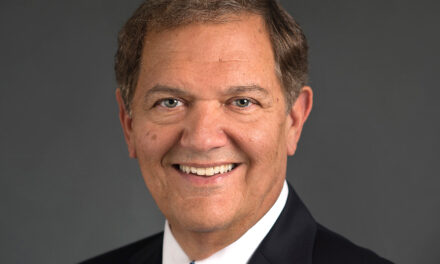
OSF HealthCare pilots virtual nursing to reduce burnout and improve patient experience
If you ask Ernest Cummings, a newer Peoria resident who found himself in the hospital for a diabetes-related condition, OSF HealthCare should continue using virtual nurses.
“It was better. Sometimes they (nurses) have other patients and sometimes it does take too long and sometimes I’m impatient,” Cummings says with a laugh. “But it was nice today,” he said after his hospital discharge discussion with OSF OnCall Virtual Nurse Laurice Domingo.
Before his discharge from the medical surgical unit at OSF HealthCare Saint Francis Medical Center, Domingo touched base with a multidisciplinary team including his attending physician, social worker and anyone else who might have been part of Cummings’ care. Then Domingo popped onto the TV screen in the room, introduced herself and went through paperwork that had already been given to Cummings to look over before the video chat. Domingo makes sure to ask if Mr. Cummings is clear on next steps and if he has any other needs.
“How about transportation? “Yes. My brother is probably downstairs waiting for me,” Cummings shares. Domingo closes out the visit. “If there isn’t anything else I can help you with, I’ll let you go so you can go home!”
OSF HealthCare is piloting virtual nursing on three medical surgical floors, covering about 75 patients at its flagship medical center, Saint Francis Medical Center in Peoria. The Performance Improvement division at OSF Innovation was tapped to design how virtual nurses through OSF OnCall Digital Health, can reduce the burden of bedside nurses and create a better patient experience leveraging the right technology. The pilot is testing two different approaches using installed technology on TVs in patient rooms that allow an audio-visual connection with the patient, and another that involves bringing in a tablet for the patient to use.
Domingo is already a pro at virtual nursing after having been part of the launch of the OSF OnCall Digital Hospital in August of 2022. She currently works from the OSF OnCall building in downtown Peoria but Brandi Clark, vice president of Digital Care says that could change in the future to help recruit and retain virtual nurses who might want to work from home.
OSF OnCall and nursing leaders haven’t yet settled on the technology platform that’ll be used but Clark says there is an advantage to hard-wired technology on television screens.
Patient feedback has been positive
“Patients certainly have expressed that they have had a good experience with the virtual nurse both with the tablet as well as with the installed technology in the room. A real benefit to the installed technology for the bedside nurses is that it requires no work from them to bring that technology into the room to the patient.”
So far, OSF OnCall virtual nurses have mostly been involved in admissions and discharges which can be time-consuming and often leads to patients waiting for a bedside nurse to become available. OSF Saint Francis Medical Center Vice President-Chief Nursing Officer Jennifer Croland says they are also testing other ways to potentially use virtual nurses, including allowing the remote nurse to provide patient education.
“We’ve also looked at things like scribing patient assessments, doing regular rounding in the rooms to check on the patients, completing checklists and providing information on discharge appointments. And setting those up. So, there’s been a fair amount that we’ve tried to do and we’re really still trying to land on what is best for that virtual nurse to do.”
The lessons learned to date include the importance of good communication between the virtual nurse and the bedside nurse.
Over a four-month period of the pilot, virtual nurses completed 93.4% of admissions and 87.7% of discharges, freeing up bedside nurse time. Completion of advanced care directive forms to document end-of-life wishes and patient education documentation increased from 60% to 100%.
Skeptical bedside nurses have come to appreciate the support a virtual nurse can provide in alleviating some timely tasks that take them from direct care. Brandi Clark says many hospital systems are testing options to see what works best and is cost neutral, while reducing nurse burnout.
“While there is not necessarily published, evidence-based literature out there to say, ‘this is how it should work,’ we are all learning together about how this will help optimize care for patients in the inpatient setting in the future.”
While the pilot continues, the OSF Performance Improvement team is collaborating with frontline Mission Partners and leaders to continue to design the model and workflows to expand how OSF HealthCare can leverage virtual nursing care across its 16 hospitals.






